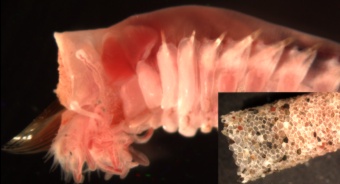| Pectinaria australis Ehlers, 1904. Family Pectinariidae | ||||
|
Pectinaria australis anterior and tube. [Click photo for picture page] 
| ||||
| Habitat: | Intertidal. Soft shore. Enclosed harbours and sheltered bays. Fine sand to muddy sand. Infaunal. Depth range: 0-70 (m). Salinity regime: Estuary-like variation. Microhabitat: Mid tide to coastal shallows, feeding head down with tube tip near surface. Tube: Cemented sand grain cone. | |||
| Occurrence: | Consistently occurring. Density: 2000 (m2).
Distribution in NZ: New Zealand estuaries, harbours, and coast | |||
| Feeding guild: | Subsurface deposit-feeding/herbivore. | |||
| Diagnosis: | Genus Pectinaria in Family Pectinariidae.
A typical pectinariid! That is a short, conical, blunt-headed worm in a matching conical tube (up to about 45 mm long) elegantly constructed of one fragile layer of cemented sand grains. Golden paleae (digging chaetae) present in 2 sets on operculum (blunt head plate). Pectinaria australis is a Lagis-group species with 16 chaetigers, of which 12 are uncigerous (from 4th), first branchial segment with lappets, opercular plate corrugated and rim raised, a papilla between paleae, scaphe (tail structure) ornamentations distinctive and 6 scaphal hooks each side. Two pair of lamellate branchiae. Colour: Pigmentation patterns absent except for small areas of reddish spots anteriorly, mostly ventro-laterally on the post-mouth (2nd tentacular cirrus) segment, and ventrally on the first chaetigerous segments. Maximum size: 45 mm total length, 7 mm body width, for 16 chaetigers. |
|||
| Notable aspect: | Cone tube delicate architecture, blunt head with golden digging chaetae. | |||
| Comparisons: | The parapodia of this polychaete are somewhat similar to ampharetids when found in a sample with tube lost, but the plug-like body can only be a Pectinaria australis. | |||
| Taxonomy: | There is only one intertidal/coastal pectinariid species in New Zealand. Hutchings and Peart (2002) reviewed Australian species of the family, but did not include Pectinaria australis | |||
| Distribution: | Endemic. Known only from New Zealand. | |||
| Biology: | Populations tend to be aggregated, and sporadic from year to year. Adults densest just subtidally in shallow harbours. Density may increase around sources of organic pollution and in eelgrass beds, but Pectinaria australis is also found in clean sand where population density is likely to be less than 50/m2. A short life cycle of one year with recruitment in late summer was reported in both intertidal and offshore population studies of this species, though probably some individuals survive two years. Thus adults will be most noticeable in autumn-winter. When handled Pectinaria australis produce a copious clear mucus, perhaps as a defense strategy. | |||
| Best References: | Biology: Estcourt (1974) Population study of Pectinaria australis (Polychaeta) in Tasman Bay. New Zealand Journal of Marine and Freshwater Research 8:283-289 Taxonomy: No recommendation. | |||
| More information: |
Synonyms, NZ records | Original figures | Original description details | |
| Genus diagnosis | More pictures | Further references (biology, etc) | Family Pectinariidae | |
| Internet sources: |
GOOGLE Search | AlltheWeb Search | CISTI | CBIF BiOSC Gateway | GOBASE Molecular | GenBank | Genus only in GenBank | | |||
| Genus only in Ubio Taxonomic Name Server | PubMed | Scirus | Zoological Record | | ||||
|
Note: use the Back button of your browser to return to Shore Polychaete Guide. |
||||